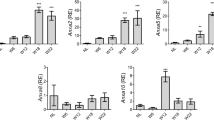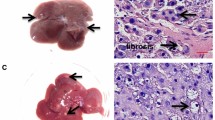Abstract
Overexpression of CD147/basigin in hepatic cells promotes the progression of hepatocellular carcinoma (HCC). Whether CD147 also expressed in liver non-parenchymal cells and associated with HCC development was unknown. The aim of the study was to explore time-dependent cell expression patterns of CD147 in a widely accepted N-diethylnitrosamine/phenobarbital (DEN/PB)-induced HCC mouse model. Liver samples collected at month 1–12 of post-DEN/PB administration were assessed the localization of CD147 in hepatocytes, endothelial cells, hepatic stellate cells, and macrophages. Immunohistochemistry analysis showed that CD147 was upregulated in liver tumors during month 1–8 of DEN/PB induction. Expression of CD147 was positively correlated with cytokeratin 18, a hepatocyte marker (r = 0.7857, P = 0.0279), CD31 (r = 0.9048, P = 0.0046), an endothelial cell marker, and CD68, a macrophage marker (r = 0.7619, P = 0.0368). A significant correlation was also observed between CD147 and alpha-smooth muscle actin (r = 0.8857, P = 0.0333) at DEN/PB initiation and early stage of tumor formation. Immunofluorescence and fluorescence in situ hybridization showed that CD147 co-expressed with cytokeratin 18, CD31, alpha-smooth muscle actin, and CD68. Moreover, there existed positive correlations between CD147 and microvessel density (r = 0.7857, P = 0.0279), CD147 and Ki-67 (r = 0.9341, P = 0.0022) in the development of DEN/PB-induced HCC. In conclusion, our results demonstrated that CD147 was upregulated in the liver parenchymal and mesenchymal cells and involved in angiogenesis and tumor cell proliferation in the development of DEN/PB-induced HCC.







Similar content being viewed by others
References
Athanassiadou P, Psyhoyiou H, Grapsa D, Gonidi M, Ketikoglou I, Patsouris E (2007) Cytokeratin 8 and 18 expression in imprint smears of chronic viral hepatitis, autoimmune hepatitis and hepatocellular carcinoma. A preliminary study. Acta Cytol 51:61–65
Cervello M, Foderàa D, Florena AM, Soresi M, Tripodo C, D’Alessadro N, Montalto G (2005) Correlation between expression of cyclooxygenase-2 and the presence of inflammatory cells in human primary hepatocellular carcinoma: possible role in tumor promotion and angiogenesis. World J Gastroenterol 11:4638–4643
Chang R, Wei L, Lu Y, Cui X, Lu C, Liu L, Jiang D, Xiong Y, Wang G, Wan C, Qian H (2014) Upregulated expression of ubiquitin-conjugating enzyme E2Q1 (UBE2Q1) is associated with enhanced cell proliferation and poor prognosis in human hepatocellular carcinoma. J Mol Histol. doi:10.1007/s10735-014-9596-x
Chen Y, Gou X, Ke X, Cui H, Chen Z (2012) Human tumor cells induce angiogenesis through positive feedback between CD147 and insulin-like growth factor-I. PLoS One. doi:10.1371/journal.pone.0040965
Chen Y, Zhang H, Gou X, Horikawa Y, Xing J, Chen Z (2009) Upregulation of HAb18G/CD147 in activated human umbilical vein endothelial cells enhances the angiogenesis. Cancer Lett 278:113–121
Cui X, Liu Y, Wan C, Lu C, Cai J, He S, Ni T, Zhu J, Wei L, Zhang Y, Qian H (2014) Decreased expression of SERPINB1 correlates with tumor invasion and poor prognosis in human hepatocellular carcinoma. J Mol Histol 45:59–68
Diwan BA, Rice JM, Ward JM, Ohshima M, Lynch PH (1984) Inhibition by phenobarbital and lack of effect of amobarbital on the development of liver tumors induced by N-nitrosodiethylamine in juvenile B6C3F1 mice. Cancer Lett 23:223–234
Drucker C, Parzefall W, Teufelhofer O, Grusch M, Ellinger A, Schulte-Hermann R, Grasl-Kraupp B (2006) Non-parenchymal liver cells support the growth advantage in the first stages of hepatocarcinogenesis. Carcinogenesis 27:152–161
El-Serag HB, Rudolph KL (2007) Hepatocellular carcinoma: epidemiology and molecular carcinogenesis. Gastroenterology 132:2557–2576
Godoy P, Hewitt NJ, Albrecht U et al (2013) Recent advances in 2D and 3D in vitro systems using primary hepatocytes, alternative hepatocyte sources and non-parenchymal liver cells and their use in investigating mechanisms of hepatotoxicity, cell signaling and ADME. Arch Toxicol 87:1315–1530
Kanekura T, Chen X (2010) CD147/basigin promotes progression of malignant melanoma and other cancers. J Dermatol Sci 57:149–154
Kawai M, Saegusa Y, Kemmochi S, Harada T, Shimamoto K, Shibutani M, Mitsumori K (2010) Cytokeration8/18 is useful immunohistochemical marker for hepatocellular proliferative lesions in mice. J Vet Med Sci 72:263–269
Ku NO, Strnad P, Zhong BH, Tao GZ, Omary MB (2007) Keratins let liver live: mutations predispose to liver disease and cross linking generates Mallory–Denk bodies. Hepatology 46:1639–1649
Lan X, Xiao F, Ding Q, Liu J, Liu J, Zhang J, Tian DA (2014) The effect of CXCL9 on the invasion ability of hepatocellular carcinoma through up-regulation of PREX2. J Mol Histol. doi:10.1007/s10735-014-9593-0
Lee JS, Chu IS, Mikaelyan A, Calvisi DF, Heo J, Reddy JK, Thorgerisson SS (2004) Application of comparative functional genomics to identify best-fit mouse models to study human cancer. Nat Genet 36:1306–1311
Liu K, He X, Lei XZ, Zhao LS, Tang H, Liu L, Lei BJ (2003) Pathomological study on location and distribution of kupffer cells in HCC. World J Gastroenterol 9:1946–1949
Liu Z, Wu X, Zhang F, Han L, Bao G, He X, Xu Z (2013) AhR expression is increased in hepatocellular carcinoma. J Mol Histol 44:455–461
Li Y, Xu J, Chen L, Zhong WD, Zhang Z, Mi L, Zhang Y, Liao CG, Bian HJ, Yang XM, Li XY, Fan CM, Zhu P, Fu L, Chen ZN (2009) HAb18G (CD147), a cancer-associated biomarker and its role in cancer detection. Histopathology 54:677–687
Maeda S, Kamata H, Luo JL, Leffert H, Karin M (2005) IKK beta couples hepatocyte death to cytokine-driven compensatory proliferation that promotes chemical hepatocarcinogenesis. Cell 121:977–990
Nasr M, Selima E, Hamed O, Kazem A (2014) Targeting different angiogenic pathways with combination of curcumin, leflunomide and perindopril inhibits diethylnitrosamine-induced HCC in mice. Eur J Pharmacol 15:267–275
Pusztaszeri MP, Seelentag W, Bosman FT (2006) Immunohistochemical expression of endothelial markers CD31, CD34, von Willebrand factor, and Fli-1 in normal human tissue. J Histochem Cytochem 54:385–395
Ru NY, Wu J, Chen ZN, Bian H (2014) HAb18G/CD147 is involved in TGF-β-induced epithelial–mesenchymal transition and hepatocellular carcinoma invasion. Cell Biol Int. doi:10.1002/cbin.10341
Sato A, Nakashima H, Nakashima M, Ikarashi M, Nishiyama K, Kinoshita M, Seki S (2014) Involvement of the TNF and FasL produced by CD11b Kupffer cells/macrophages in CCl4-induced acute hepatic injury. PLoS One 9:e92515
Sato M, Suzuki S, Senoo H (2003) Hepatic stellate cells: unique characteristics in cell biology and phenotype. Cell Struct Funct 28:105–112
Schmitt Graff A, Kruger S, Bochard F, Gabbiani G, Denk H (1991) Modulation of α-smooth muscle actin and desmin expression in perisinusoidal cells of normal and diseased human livers. Am J Pathol 138:1233–1242
Schmilovitz-Weiss H, Tobar A, Halpern M, Levy I, Shabtai E, Ben-Ari Z (2011) Tissue expression of squamous cellular carcinoma antigen and Ki67 in hepatocellular carcinoma-correlation with prognosis: a historical prospective study. Diagn Pathol 6:121
Shih SC, Robinson GS, Perruzzi CA, Calvo A, Desai K, Green JE, Ali IU, Smith LE, Senger DR (2002) Molecular profiling of angiogenesis markers. Am J Pathol 161:35–41
Sugimachi K, Tanaka S, Terashi T, Taguchi K, Rikimaru T, Sugimachi K (2002) The mechanisms of angiogenesis in hepatocellular carcinoma: angiogenic switch during tumor progression. Surgery 131:S135–S141
Tang Y, Nakada MT, Kesavan P, McCabe F, Millar H, Raffety P, Buqelski P, Yan L (2005) Extracellular matrix metalloproteinase inducer stimulates tumor angiogenesis by elevating vascular endothelial cell growth factor and matrix metalloproteinases. Cancer Res 65:3193–3199
Trerotoli P, Fransvea E, Angelotti U, Antonaci G, Lupo L, Mazzocca A, Antonaci S, Mangia A, Giannelli G (2009) Tissue expression of squamous cellular carcinoma antigen (SCCA) is inversely correlated to tumor size in HCC. Mol Cancer 8:29
Verna L, Whysner J, Williams GM (1996) N-nitrosodiethylamine mechanistic data and risk assessment: bioactivation, DNA-adduct formation, mutagrnicity, and tumor initiation. Pharmacol Ther 71:57–81
Watanabe J, Kushihata F, Honda K, Suqita A, Tateishi N, Mominoki K, Matsuda S, Kobayashi N (2004) Prognostic significance of Bcl-xL in human hepatocellular carcinoma. Surgery 135:604–612
Weidle UH, Scheuer W, Eggle D, Klostermann S, Stockinger H (2010) Cancer-related issues of CD147. Cancer Genomics Proteomics 7:157–169
Weidner N (1995) Current pathologic methods for measuring intratumoral microvessel density within breast carcinoma and other solid tumors. Breast Cancer Res Treat 36:169–180
Wu J, Ru NY, Zhang Y, Li Y, Wei D, Ren Z, Huang XF, Chen ZN, Bian H (2011) HAb18G/CD147 promotes epithelial–mesenchymal transition through TGF-β signaling and is transcriptionally regulated by Slug. Oncogene 30:4410–4427
Wu YY, Chen L, Wang GL, Zhang YX, Zhou JM, He S, Qin J, Zhu YY (2013) Inhibition of hepatocellular carcinoma growth and angiogenesis by dual silencing of NET-1 and VEGF. J Mol Histol 44:433–445
Xiong LJ, Edwards CK, Zhou LJ III (2014) The biological function and clinical utilization of CD147 in human diseases: a review of the current scientific literature. Int J Mol Sci 15:17411–17441
Xu J, Xu HY, Zhang Q, Song F, Jing JL, Yang XM, Mi L, Wen N, Tian R, Wang L, Yao H, Feng Q, Zhang Y, Xing JL, Zhu P, Chen ZN (2007) HAb18G/CD147 functions in invasion and metastasis of hepatocellular carcinoma. Mol Cancer Res 5:605–614
Yang JD, Nakamura I, Roberts LR (2011) The tumor microenvironment in hepatocellular carcinoma: current status and therapeutic targets. Semin Cancer Biol 21:35–43
Nikoozad Z, Ghorbanian MT, Rezaei A (2014) Comparison of liver function and hepatic specific genes expression in cultured mesenchymal stem cells and hepatocytes. Iran J Basic Med Sci 17:27–33
Zhang Q, Zhou J, Ku XM, Chen XG, Zhang L, Xu J, Chen GS, Li Q, Qian F, Tian R, Wen N, Chen ZN (2007) Expression of CD147 as a significantly unfavorable prognostic factor in hepatocellular carcinoma. Eur J Cancer Prev 16:196–202
Zhang DW, Zhao YX, Wei D, Li YL, Zhang Y, Wu J, Xu J, Chen C, Zhang W, Gong L, Han Y, Chen ZN, Bian H (2012) HAb18G/CD147 promotes activation of hepatic stellate cells and is a target for antibody therapy of liver fibrosis. J Hepatol 57:1283–1291
Zhao W, Zhang L, Yin Z, Su W, Ren G, Zhou C, You J, Fan J, Wang X (2011) Activated HSCs promote HCC development in immunocompetent mice. Int J Cancer 129:2651–2661
Zhao S, Chen C, Liu S, Zeng W, Su J, Wu L, Luo Z, Zhou S, Li Q, Zhang J, Kuang Y, Chen X (2013a) CD147 promotes MTX resistance by immune cells through up-regulating ABCG2 expression and function. J Dermatol Sci 70:182–189
Zhao Y, Chen S, Gou WF, Niu ZF, Zhao S, Xiao LJ, Takano Y, Zheng HC (2013b) The role of EMMPRIN expression in ovarian epithelial carcinomas. Cell Cycle 12:2899–2913
Zhu AX, Duda DG, Sahani DV, Jain RK (2011) HCC and angiogenesis: possible targets and future directions. Nat Rev Clin Oncol 8:292–301
Zhu S, Li Y, Zhang Y, Wang X, Gong L, Han X, Yao L, Lan M, Zhang W (2014) Expression and clinical implications of HAb18G/CD147 in hepatocellular carcinoma. Hepatol Res. doi:10.1111/hepr.12320
Acknowledgments
This work was supported by grants from the National Natural Science Foundation of China (No. 81172144) and the National Science and Technology Major Project (Nos. 2012ZX10002-015 and 2012AA020806).
Conflict of interest
All the authors declare no conflict of interest.
Author information
Authors and Affiliations
Corresponding authors
Rights and permissions
About this article
Cite this article
Lu, M., Wu, J., He, F. et al. Cell expression patterns of CD147 in N-diethylnitrosamine/phenobarbital-induced mouse hepatocellular carcinoma. J Mol Hist 46, 79–91 (2015). https://doi.org/10.1007/s10735-014-9602-3
Received:
Accepted:
Published:
Issue Date:
DOI: https://doi.org/10.1007/s10735-014-9602-3




